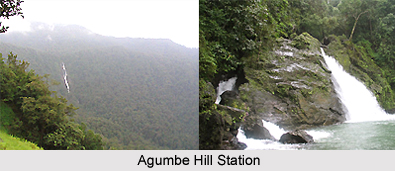 Agumbe Hill Station is one of the beautiful hill stations in Karnataka and is famous for its sunsets, waterfalls and for its research unit on King Cobra in India. The hill station is accessible from Srinegri, Manipal, Kollur, Shimoga and Bengaluru by road. The nearest railway stations are Udupi and Shimoga.
Agumbe Hill Station is one of the beautiful hill stations in Karnataka and is famous for its sunsets, waterfalls and for its research unit on King Cobra in India. The hill station is accessible from Srinegri, Manipal, Kollur, Shimoga and Bengaluru by road. The nearest railway stations are Udupi and Shimoga.
Agumbe Hill Station is a beautiful hillside perched in the Shimoga district; and is located in the backdrop of Nishani Gudda. This is the perfect spot for people who need to unwind amidst a serene environment. For adventurous travellers there are trekking trails but one needs permission from the forest department before setting out on journey. In Karnataka Agumbe Hill Station is also known as the place that receives highest rainfall.
The hill station`s first claim to fame was when R. K. Narayan`s famous novel Malgudi Days was shot here. However, the striking feature of this place is its forest. The forest will lead one to a jungle pond known as Emkal Kere. One can also check out the Barkana Falls. There is an ancient temple dating back to 14th century. This temple is dedicated to Lord Gopalakrishna and is built in Hoysala style developed during the reign of Hoysala Empire. The Hoysala Empire was concentrated in the south of India and they were really prominent at that period of time. They ruled between the 10th and the 14th centuries. The Hoysala rulers rose to power by taking advantage of the conflicting western Chalukya Dynasty and Kalachuris kingdom. They annexed the fertile areas of Kaveri river and present day Karnataka region.
Agumbe Hill Station is popular for its Rainforest Research Station set up by Romulus Whitaker, a renowned herpetologist. Agumbe Hill Station is seen as an important dwelling place for King Cobra. The main aim of this reserve is to conserve the cobras. For this purpose, a huge area has been turned into the reserve. Apart from the serpents, and other animals are kept in the adjoining land of the research unit. Ayurveda is also an important part of Indian history. All necessary measures have been taken to protect and grow the medicinal plants here.
Nestled between Malnad and Western Ghats (Western Ghats Mountain Range in India) the surrounding land is blessed with rich flora and fauna. Here animals are found in abundance. Hence, natural reserves like Someshwara Wildlife Sanctuary and Kudremukh National Park are located near Agumbe Hill Station.
Cascading falls are an integral part of the hill stations in Karnataka. Kunchikal Falls is the highest waterfall in India. The source river for this fall is Varahi River. This waterfall is located at a height of 455 meters. Barkana Falls and Onake Abbi Falls will also be a part of your trip to Agumbe, Karnataka.
Agumbe has a sunset point, which receives lot of visitors. On a clear day, one can see the sun setting over the Arabian Sea</b> though the sea is at quite a distance from Agumbe



















